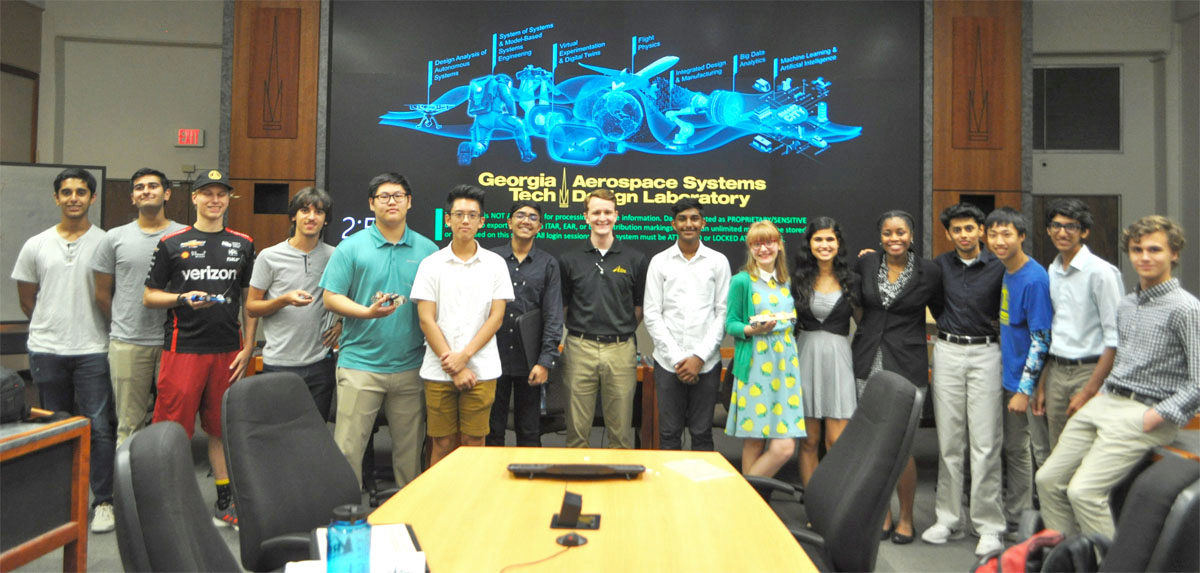
The Next Generation of Engineers: Rising high school juniors and seniors from 11 Atlanta-area high schools learned systems engineering, additive manufacturing, and the importance of team work during the three-week summer camp. View more photos
The AE School's Aerospace Systems Design Lab (ASDL) introduced 16 Atlanta-area high school students to college-level engineering this summer during the sixth annual Science, Technology, and Engineering Pipeline (STEP) camp, June 10 -27.
 |
| Dimitri Mavris |
Sponsored by the AE School, Lockheed Martin, and the Georgia Space Grant Consortium, the three-week camp wrapped up with a showcase of the students' final projects: electric-powered vehicles, built from scratch. The students had been divided into four teams and tasked with designing, manufacturing, and testing a small electric vehicle that could finish a carpeted, five-meter, straight-line course in the shortest amount of time.
“STEP is a great program in that it teaches high school students about systems engineering and how to use critical thinking to solve a challenge while working in teams," said ASDL director Dimitri Mavris.
"In addition, it gives Georgia Tech researchers and students the opportunity to mentor students."
Every year the challenge and requirements are different, providing an unique experience for all involved.
“We wanted to investigate high-performance electric vehicles, which has traditionally been difficult to do because of the constraints of the battery,” said the camp's coordinator Evan Harrison, PhDAE ’18, an ASDL research engineer.
“To achieve the speed and lightness of a high-performance vehicle, the design has to make the best use of the battery, while also remaining light in overall weight.”
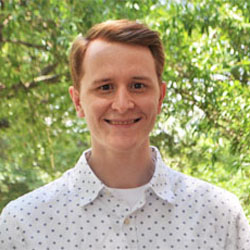 |
| Evan Harrison |
Students used minimal supplies to accomplish their goal: two small motors, four gears, four axles, eight same-sized wheels, four AA batteries, a simple receiver, and a transmitter. Though an instruction manual came with the original supplies, Harrison quickly disposed of it.
"We wanted them to build a functioning vehicle from scratch," said Harrison.
By the second week students were assembling their vehicles and beginning to test them.
"Many prototypes were crafted. Only some worked out. But that’s all part of the design process," said GSGC director Prof. Steve Ruffin.
“In college and beyond, the STEM skills and motivation imparted by STEP will serve them well,” he noted.
ASDL graduate research assistants Adam Baker, Alex Braafladt, Taylor Fazzini, Pat Meyer, Coline Ramee, and Andrew Cox helped introduce students to electrical components and specialized equipment like laser cutters and 3D printers. Along the way, they answered questions about the fundamentals of systems engineering, additive manufacturing, and the importance of team work in the field of engineering.
 |
| Parents, friends, and Lockheed engineers gathered at Weber Building on June 27 to review the final posters. |
“I’ve always been super amazed with what these students have been able to design in just three weeks,” said Steve Engelstad, a senior fellow at Lockheed Martin.
"They are excited and you can see that in their final presentations."
Though each of the teams sought to have the fastest vehicle to show, Lockheed's director of Air Vehicle Systems, Julie Whitehead reminded them all that creativity and persistence are what their future employers will be looking for.
“These students demonstrated that, with just a handful of requirements, it was possible to come up with different approaches and designs to complete their shared objectives. It was amazing to see."
Participants in the 2019 STEP camp came from North Springs High School, Druid Hills High School, Johns Creek High School, Campbell High School, Pace Academy, Walton High School, Paul Duke STEM High School, Lassiter High School, Lambert High School, Marietta High School, and Chattahoochee High School.
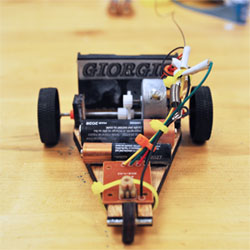 |
| Giorgio completed the course in 8.26 seconds |
Giorgio
Team Giorgio drew inspiration from the classic muscle car area. Members designed a three-wheeled vehicle - one wheel in the front and two larger ones in the back. All of the wheels were fabricated with laser-cut plywood and assembled using zip ties to secure the electronics. This design reduced weight on the driven wheel and allowed for equal torque distribution, resulting in a straight alignment, which increased efficiency.
 |
| SPEC V completed the course in 4.54 seconds |
SPEC V
The SPEcialized Carpet Vehicle (SPEC V) was the only team that 3D-printed their entire vehicle. Their custom design allowed them to include both inserts in their base (to hold the battery cases in place) and custom-made holes (to hold their axles in place). Together, these two design features reduced vehicle weight. Their final design involved five wheels, two axles, and rear-wheel driving.
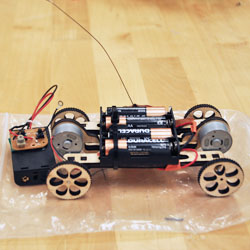 |
| A.N.G.L.E.R. completed the course in 4.53 seconds |
A.N.G.L.E.R.
The Advanced Non-General LinEar Racer (A.N.G.L.E.R.) was an all-wheel drive vehicle whose body and wheels were fabricated out of plywood that was shaped in the Yang Aero Maker Space using the laser cutter. The wheels included intricate ridges that helped push the vehicle off the carpet. The team got its inspiration from Formula One racing cars that have contoured body designs and optimized shapes for decreased drag.
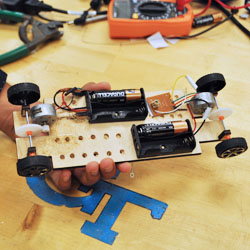 |
| Jermaine C completed the course in 3.5 seconds |
Jermaine C
The name of this vehicle was inspired by recording artist J.Cole, whose lyrics captured a little bit of the lesson the student engineers learned about vehicle design:
“The good news is you came a long way
The bad news is you went the wrong way."
And the lesson? Their two motors were operating in two different directions. Through three iterations they found that the fastest design could be achieved by having the motors power the wheels in the same direction, along with lowering and lengthening the body of the vehicle.